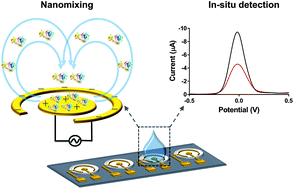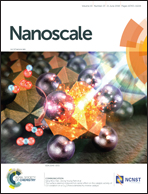Interfacial nano-mixing in a miniaturised platform enables signal enhancement and in situ detection of cancer biomarkers†
Abstract
Interfacial biosensing performs the detection of biomolecules at the bare-metal interface for disease diagnosis by comparing how biological species derived from patients and healthy individuals interact with bare metal surfaces. This technique retrieves clinicopathological information without complex surface functionalisation which is a major limitation of conventional techniques. However, it is still challenging to detect subtle molecular changes by interfacial biosensing, and the detection often requires prolonged sensing times due to the slow diffusion process of the biomolecules towards the sensor surface. Herein, we report on a novel strategy for interfacial biosensing which involves in situ electrochemical detection under the action of an electric field-induced nanoscopic flow at nanometre distance to the sensing surface. This nanomixing significantly increases target adsorption, reduces sensing time, and enables the detection of small molecular changes with enhanced sensitivity. Using a multiplex electrochemical microdevice that enables nanomixing and in situ label-free electrochemical detection, we demonstrate the detection of multiple cancer biomarkers on the same device. We present data for the detection of aberrant phosphorylation in the EGFR protein and hypermethylation in the EN1 gene region. Our method significantly shortens the assay period (from 40 min and 20 min to 3 minutes for protein and DNA, respectively), increases the sensitivity by up to two orders of magnitude, and improves detection specificity.



 Please wait while we load your content...
Please wait while we load your content...